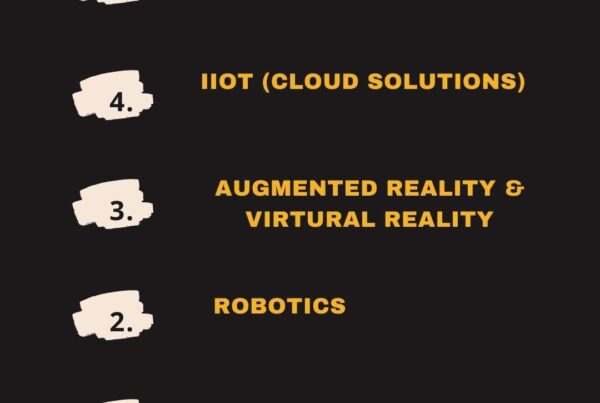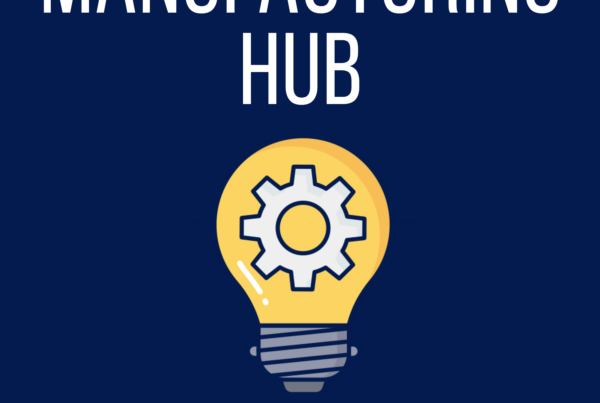The Digital Transformation Quick Start Guide
Today, I would like to introduce to you the digital transformation quick start guide; five steps in order to get you started in digital transformation. But first I’d like to put a definition of digital transformation out there and tell you why it’s important.
Digital transformation is the concerted effort of tying together operations in IT and then using that data across the entire enterprise. From the uncarpeted spots on the plant floor, from raw materials through operations, to warehousing, to the carpeted spots, which is the information technology, all of the people who are working in the back rooms, the executives, out to the sales folks on the floor. Now, why do we want to go through a digital transformation process? Simple. We want to be able to produce more and have it cost less. And the end goal of digital transformation has to be able to safely and sustainably go through this process and build this company. Who is digital transformation for? Simply companies that want to survive.
I’ve talked in the past how in the post-COVID-19 world, there are going to be winners and they are going to be losers. The winners are going to win big, they’re going to find huge efficiencies and continue to grow their company for future generations. And the losers are simply going to go out of business because the way that we’ve done business in the past is not how we are going to be able to do business in the future. Remember, a key part of digital transformation is safety and sustainability. Why did I put together a digital transformation Quickstart guide and why am I giving it to you guys? For a couple of reasons. One, there isn’t an extremely long manual that exists and two, if you’re anything like me, you’re looking at the quick start guide as to how to get something up and running quickly.
And a big part about digital transformation is finding ways to safely and sustainably and quickly go through these processes to find ROI so that you can continue the process. So come on, let’s jump in.
I need to edit this in. Link to the whole infographic will be somewhere below and you guys can both see it on the website as well as go ahead and download it.
So the number one step as you guys can see is dream big, and this is what I want you to do. I want you to close your eyes. I want you to take a few deep breaths. If you’re going to start rebuilding your facility or your facilities from scratch, how would you do it? I want you to take a couple of breaths. I want you to go ahead and write it out. Maybe draw it out. Maybe you’re moving around machines, maybe you’re getting some different machines.
I want you to draw that out because this is going to become your roadmap. In an ideal world, what would a brand new facility look like? This is going to be a roadmap. It is a document that is going to change. You’re going to go through processes, you’re going to learn things.
That leads us into the second part, which is to start small. Not very many of us can go out and bulldoze everything and completely start over from scratch and have the capital to be able to do that. So the whole project is not going to be done in one phase. No one should tell you that this project can be done in one phase. There is no magic bullet to be able to do this. Pick an area where you can succeed and make a major impact. Maybe that’s OAE. Maybe that’s overall equipment effectiveness. And take a look at and maybe you can visualize your data.
Maybe it’s you need better process historian, maybe you’re going to use a power BI. Something along those lines. Pick something that you can make an immediate impact and you can do it in a quick amount of time. Again, speed to market, speed to getting these first phases done is going to be key. We’re starting small and as I said, we need to make an immediate impact. We need to start strong, we need to show measurable results that return on investment. We need to prove the plan and that’s the, we need to show the guys on the plant floor that this data thing, you know, it can be beneficial. We need to show the maintenance staff that they need to go in and they can benefit and not run around like crazy if we give them the ability to put maintenance in something like a CMMS and digitalize that.
We need to show the benefits of knowing what raw materials we have and what finished goods we have, and we need to start building that support internally all the way from the top level down to the plant floor and encompassing everyone in between.
And why do we need to do that? Because number four, we need to garner buy-in. In order to succeed, you’re going to need widespread support from the executives at the top to the people on the shop floor. We need to start small and make an impact, and that impact will rally support around a digital transformation initiative. We can’t develop in a bubble. It’s 2020, it’s 2021, we are moving forward with this as a country, developing a bubble is no longer going to work. We need to talk to people. We need to understand what their problems are and we need to provide solutions for those people’s problems.
The fifth step of starting a digital transformation initiative is showing results. At the end of the day, results are what matter. We need to talk about ROI, return on investment. If something costs $10 to put in and we get $20 out of it, it’s a pretty good return on investment. If phase two, three, four, five costs a million dollars, but we can expect $5 million ROI on it. By building that base and showing what the ROI looks like, it’s going to help us as we’re moving into further phases. We’re not going to do this all in one phase. By going and developing quickly by showing the results, by garnering that buy-in, by showing what the return on investment looks like, we’re going to get a push, a groundswell of support in order to continue these initiatives and that’s what we’re looking for. We’re also looking to get rid of the menial tasks, and when we look to get rid of the menial tasks, I’m not saying we should automate people out of a job.
I’m saying that we should have the conversation with these people of, Hey Sue, you know, I see that you spend nine hours a day every day scheduling this by hand. What would you do with that time if you didn’t have to spend nine hours of your shift every day scheduling? Are there other things that you would like to do? Are there other things that you can do for us? Can you potentially use that human brainpower and find other efficiencies, things and initiatives that you would like to do but have never had the time to do? And if we support our people, they are going to find ways to help us. At the end of the day, there is no better person to help us improve the process than people that live the process every single day. Now I want to hear from you guys, those that have gone through IoT or Industry 4.0or digital transformation initiatives.
What have you done that you have seen succeed in the past? What have you done that you haven’t necessarily seen succeed in the past? And from everyone else, would you be interested in me going further in-depth on these or potentially going and looking at building a digital transformation guide that actually gives you guys examples on how to do that. So please feel free to drop a comment below, hit that thumbs up button, or give me like a celebration or something else. I always like the, I always like the applause, and let me know what you guys think. And until next time I will talk to you soon. Buh-Bye.



